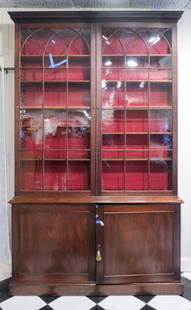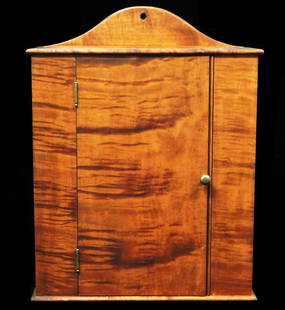
A George I field maple bureau cabinet attributed to
Similar Sale History
View More Items in Bookcases, Display Cases & ShelvesRelated Bookcases, Display Cases & Shelves
More Items in Bookcases, Display Cases & Shelves
View MoreRecommended Furniture
View More


Item Details
Description
A George I field maple bureau cabinet attributed to Coxed and Woster, early 18th century, with inlaid pewter stringing throughout, the upper section with a moulded overhanging cornice above a pair of mirror glass doors with corresponding candle slides below, the base with a fall front opening to reveal a fitted interior and two short frieze drawers over three longer graduated drawers, on replaced bun feet, 213cm high, 96.5cm wide, 58cm deep In 1719 English cabinetmaker John Coxed (fl. 1711-1718) was succeeded by his widow Grace Coxed and Thomas Woster, (fl. 1719-1735), a relative by marriage of John. The firm Coxed & Woster, operated out of John Coxed s former premises in St. Paul s Churchyard until Thomas Woster s death. Accurate dating of the firm s furniture is challenging, however the earlier cabinets were primarily veneered in burr elm or maple. Coxed & Woster is also associated with use of pewter stringing and cross-banding, as featured on the present cabinet (see C. Gilbert, Pictorial Dictionary of Marked London Furniture , 1700-1840, Leeds, 1996) Bureau cabinets bearing the trade label of Coxed & Wooster, which relate to the present example are illustrated in C. Gilbert, op. cit ., p. 154-157, figs. 236 and 245. An additional aspect of this cabinet, which is also exhibited on other documented Coxed & Woster bureau cabinets, is the presence of veneers on the top of the bureau section, despite the existence of a waist moulding to accept the upper section. This has led to the hypothesis that this workshop practice allowed the firm to retail the bureau sections independently of the bookcase surmounts (see A. Bowett & L. Lindey, 'Labelled Furniture from The White Swan Workshop in St Paul's Churchyard (1711-35)', Furniture History, 2003, pp. 74). The timber on furniture associated with the aforementioned makers is often misidentified as 'Mulberry' wood. However these distinctive veneers were typically either maple, ash, sycamore or elm stained to give a marbled effect resembling tortoisehell. The recipe for achieving this finish was described in John Stalker and George Parker's 'Treatise on Japanning and Varnishing' published in 1788. The process involved applying Nitric acid (Aqua Fortis) with metal filings to the veneers prior to rubbing in Lampblack (soot) to create the light and dark variegation to the burr veneers (see A. Bowett, Myths of English Furniture History: Mulberry Wood Furniture by Coxed and Woster , Antique Collecting, October 1998, pp. 32-35).
Buyer's Premium
- 29% up to £500,000.00
- 25% up to £1,000,000.00
- 17% above £1,000,000.00
A George I field maple bureau cabinet attributed to
Estimate £8,000 - £12,000
3 bidders are watching this item.
Shipping & Pickup Options
Item located in Berkshire, ukSee Policy for Shipping
Payment

TOP











































































